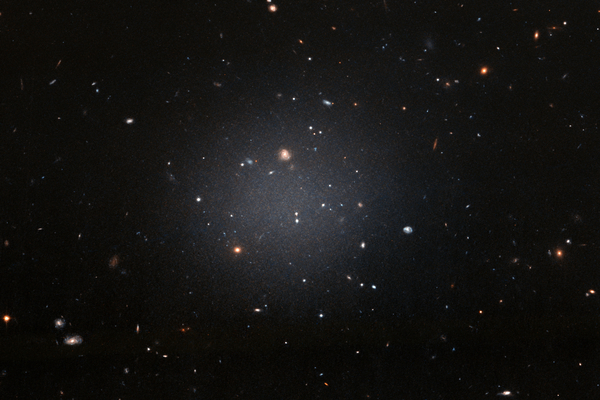Hubble finds first galaxy in the local Universe without dark matter [heic1806]
28 March 2018
An international team of researchers using the NASA/ESA Hubble Space Telescope and several other observatories have, for the first time, uncovered a galaxy in our cosmic neighbourhood that is missing most – if not all – of its dark matter. This discovery of the galaxy NGC 1052-DF2 challenges currently-accepted theories of and galaxy formation and provides new insights into the nature of dark matter. The results are published in Nature. |
| A ghostly galaxy lacking dark matter. Credit: NASA, ESA, and P. van Dokkum (Yale University) |
Astronomers using Hubble and several ground-based observatories have found a unique astronomical object: a galaxy that appears to contain almost no dark matter [1]. Hubble helped to accurately confirm the distance of NGC 1052-DF2 to be 65 million light-years and determined its size and brightness. Based on these data the team discovered that NGC 1052-DF2 larger than the Milky Way, but contains about 250 times fewer stars, leading it to be classified as an ultra diffuse galaxy.
"I spent an hour just staring at this image," lead researcher Pieter van Dokkum of Yale University says as he recalls first seeing the Hubble image of NGC 1052-DF2. "This thing is astonishing: a gigantic blob so sparse that you see the galaxies behind it. It is literally a see-through galaxy."
Further measurements of the dynamical properties of ten globular clusters orbiting the galaxy allowed the team to infer an independent value of the galaxies mass. This mass is comparable to the mass of the stars in the galaxy, leading to the conclusion that NGC 1052-DF2 contains at least 400 times less dark matter than astronomers predict for a galaxy of its mass, and possibly none at all [2]. This discovery is unpredicted by current theories on the distribution of dark matter and its influence on galaxy formation.
"Dark matter is conventionally believed to be an integral part of all galaxies – the glue that holds them together and the underlying scaffolding upon which they are built," explains co-author Allison Merritt from Yale University and the Max Planck Institute for Astronomy, Germany. And van Dokkum adds: "This invisible, mysterious substance is by far the most dominant aspect of any galaxy. Finding a galaxy without any is completely unexpected; it challenges standard ideas of how galaxies work."
Merritt remarks: "There is no theory that predicts these types of galaxies – how you actually go about forming one of these things is completely unknown."
Although counterintuitive, the existence of a galaxy without dark matter negates theories that try to explain the Universe without dark matter being a part of it [3]: The discovery of NGC 1052-DF2 demonstrates that dark matter is somehow separable from galaxies. This is only expected if dark matter is bound to ordinary matter through nothing but gravity.
Meanwhile, the researchers already have some ideas about how to explain the missing dark matter in NGC 1052-DF2. Did a cataclysmic event such as the birth of a multitude of massive stars sweep out all the gas and dark matter? Or did the growth of the nearby massive elliptical galaxy NGC 1052 billions of years ago play a role in NGC 1052-DF2's dark matter deficiency?
These ideas, however, still do not explain how this galaxy formed. To find an explanation, the team is already hunting for more dark-matter deficient galaxies as they analyse Hubble images of 23 ultra-diffuse galaxies – three of which appear to be similar to NGC 1052-DF2.
Notes
[1] The galaxy was identified with the Dragonfly Telephoto Array (DFA) and also observed by the Sloan Digital Sky Survey (SDSS). As well as the NASA/ESA Hubble Space Telescope, the Gemini Observatory and the Keck Observatory were used to study the object in more detail.
[2] Since 1884 astronomers have invoked dark matter to explain why galaxies do not fly apart, given the speed at which the stars within galaxies move. From Kepler's Second Law it is expected that the rotation velocities of stars will decrease with distance from the centre of a galaxy. This is not observed.
[3] The MOND theory – Modified Newtonian Dynamics – suggests that the phenomena usually attributed to dark matter can be explained by modifying the laws of gravity. The result of this would be that a signature usually attributed to dark matter should always be detected, and is an unavoidable consequence of the presence of ordinary matter.
More information
The Hubble Space Telescope is a project of international cooperation between ESA and NASA.
The results were published in a paper entitled "A galaxy lacking dark matter" in the journal Nature.
The international team of astronomers in this study consists of P. van Dokkum (Yale University, USA), S. Danieli (Yale University, USA), Y. Cohen (Yale University, USA), A. Merritt (Yale University, USA; Max Planck Institute for Astronomy, Germany), A.J. Romanowsky (San José State University, USA; University of California Observatories, USA), R. Abraham (University of Toronto, Canada), J. Brodie (University of California Observatories, USA), C. Conroy (Harvard-Smithsonian Center for Astrophysics, USA), D. Lockhurst (University of Toronto, Canada), L. Mowla (Yale University, USA), E. O'Sullivan (Harvard-Smithsonian Center for Astrophysics, USA), and J. Zhang (University of Toronto, Canada).
Contacts
Pieter van Dokkum
Yale University
Yale, USA
Tel: +001 2034323019
Email: pieter.vandokkum![]() yale.edu
yale.edu
Allison Merritt
Max Planck Institute for Astronomy
Heidelberg, Germany
Tel: +49 6221 528-455
Email: merritt![]() mpia.de
mpia.de
Mathias Jäger
ESA/Hubble, Public Information Officer
Garching bei München, Germany
Tel: +49 176 62397500
Email: mjaeger![]() partner.eso.org
partner.eso.org


